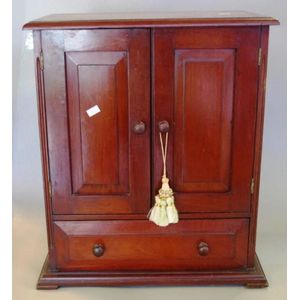Mahogany Linen Press with Gilt Detailing
You must be a subscriber, and be logged in to view price and dealer details.
Subscribe Now to view actual auction price for this item
When you subscribe, you have the option of setting the currency in which to display prices to $Au, $US, $NZ or Stg.
- Inlay - Decorative patterns inserted into the main body of a piece of furniture, generally in wood of contrasting colour and grain, though brass, ivory, ebony, shell and sometimes horn have been used. Inlay may consist of a panel of well figured timber inset into a cabinet door front, geometric patterns, or complex and stylized designs of flowers, swags of foliage, fruits and other motifs. As a general rule, in pieces where the carcase is constructed in the solid, the inlay is relatively simple such as stringing, cross banding and herringbone banding. Where more elaborate and decorative work was required veneer was used. Inlay has been fashionable from at least the latter half of the 17th century, when a variety of elaborate forms were developed
- Mahogany - Mahogany is a dense, close grained red-coloured timber from the West Indies and Central America. It was first imported into Europe in the the early 18th century and its use continued through the 19th century. It was popular for furniture making because of its strength, the wide boards available, the distinctive grain on some boards, termed flame mahogany and the rich warm colour of the timber when it was polished.. The "flame" was produced where a limb grew out from the trunk of the tree, and this timber was usually sliced into veneers for feature panels on doors, backs and cornices.
Some terms used to describe mahogany relate to the country from which it originally came, such as "Cuban" mahogany, "Honduras" mahogany etc. However unless the wood has been tested the names assigned are more a selling feature, rather than a true indication of the timber's origin. - Parquetry - Parquetry is inlay laid in geometric patterns, the contrast being achieved by the opposing angles of the grain and veneers. The herringbone pattern is the most commonly used in flooring, but this is almost never seen in furniture - the patterns used are more complex and unlike flooring, can include several different varieties of timber.
This item has been included into following indexes:
- linen presses 63
-
wardrobes, period or style
- gent's press 150
- Victorian 225
Visually similar items

A West Australian jarrah Colonial two door. Gentleman's press, c.1870-1880, maker unknown, having a two door upper robe, with interior hanging, hooks, over a lower two drawer chest of drawers. Note: with a rich warm colour patination. Height 182.5 cm. Widt

A pine clothes press, early 19th century, with a pair of cupboard doors above three long drawers, 13 cm wide, 207 cm high, 50 cm deep

Miniature apprentice cabinet / wardrobe, drawer to base and top cupboard. Height 46 cm, width 40 cm.

A Louis XV inlaid walnut armoire, French 18th century, with applied decorative panels and central parquetry star motif to the doors, on squat bun feet, 235 cm high, 170 cm wide and 63 cm deep
